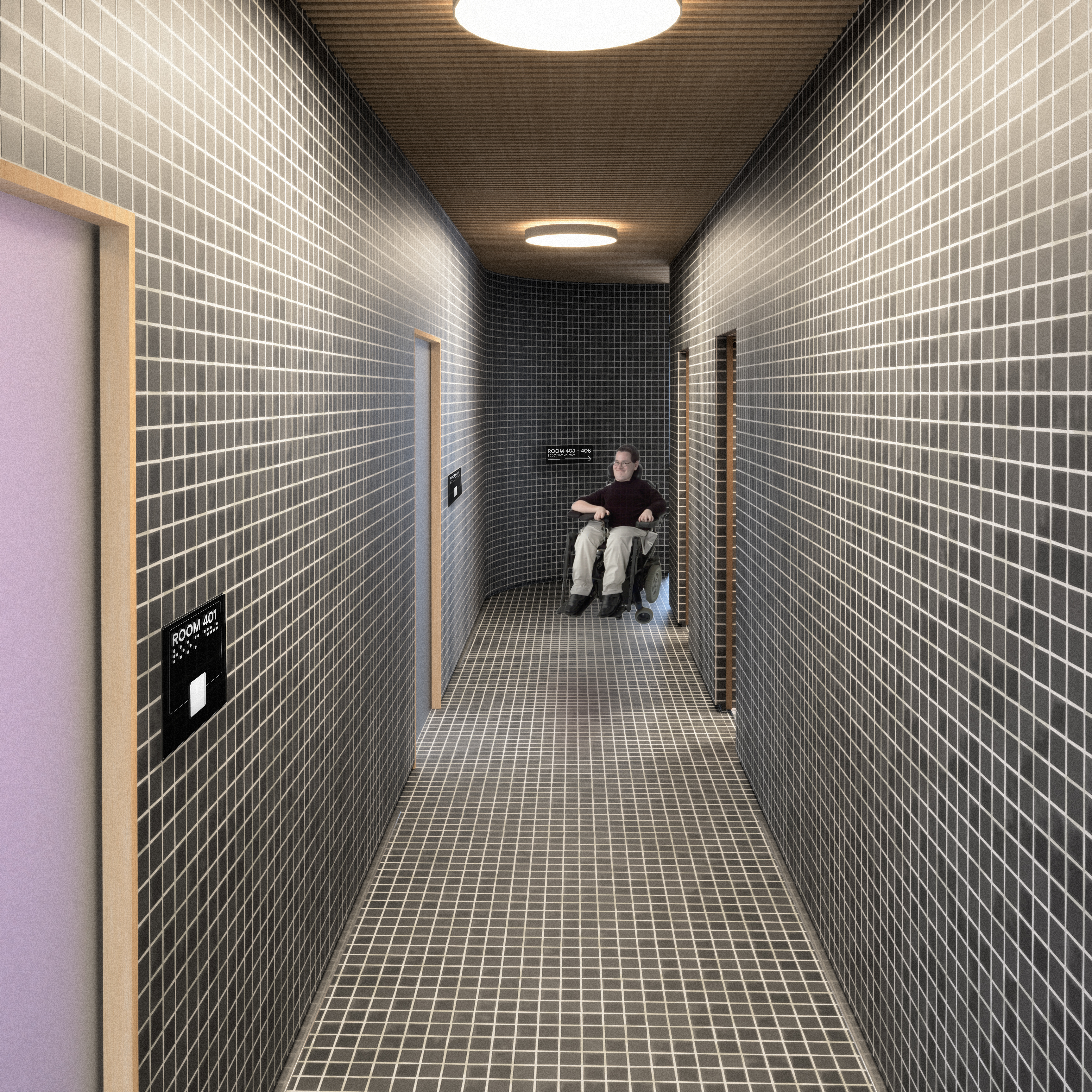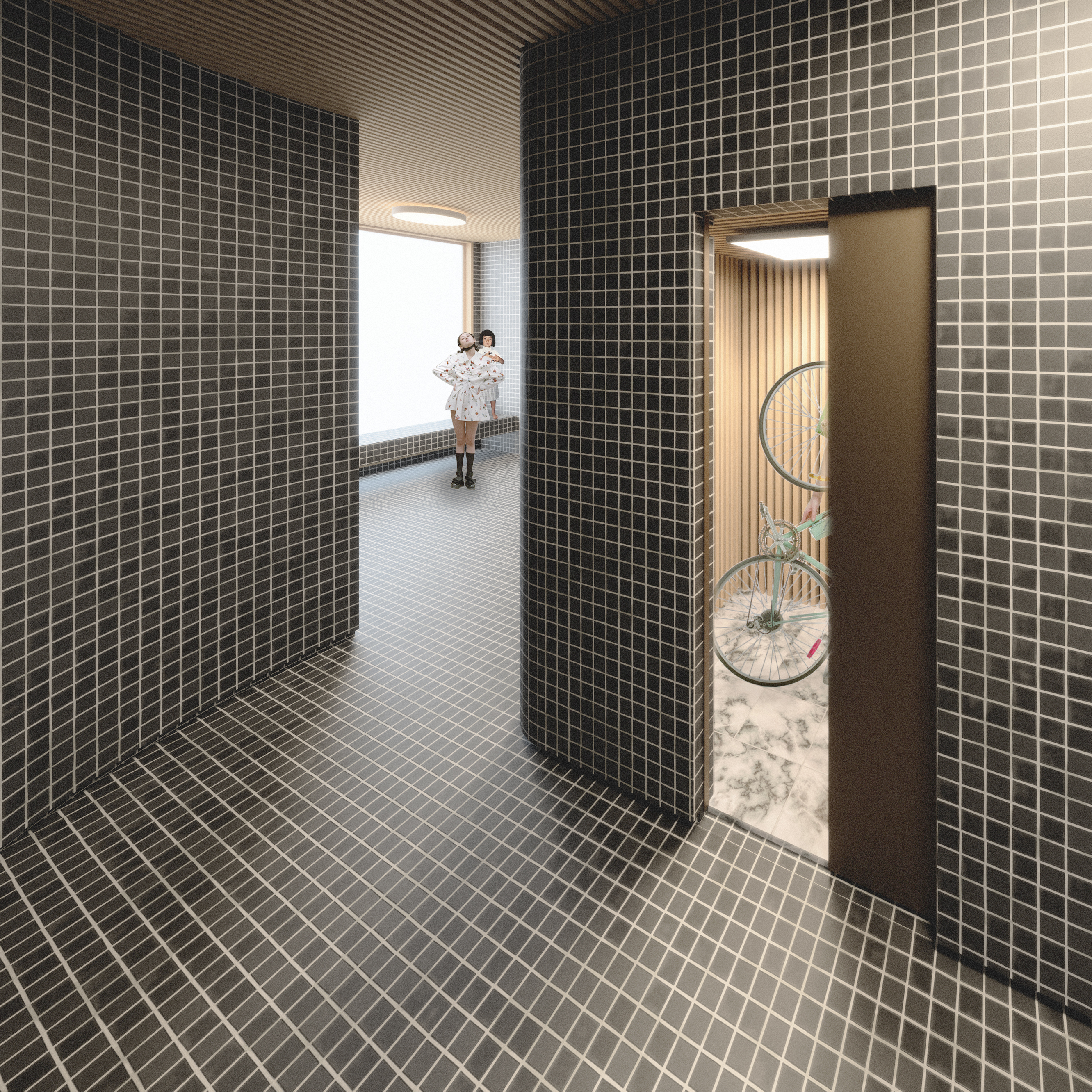Pissing in Public
The
Role of the Public Washroom in a Neoliberal City
Emily Scoular
The role of the public washroom exists as a byproduct of expansive yet latent neoliberal agendas: consumption-based citizenship, privatisation of public institutions (not limited to those of the health authorities, housing, and education), and an obsession with growth. The power of citizenship is limited to the power of productive participation. The result of which is a hybridised understanding of not only the role and right to public washrooms, but the role and right to the city, and the collectives’ limited access to public-private space.

The public washroom as public-private space, is a humble, but fundamental aspect of everyday, contemporary life. Through its unassuming nature, the impact of the public washroom is often overlooked as an essential service for the public realm of a functioning city. No better words can express this than those of Alexander Kira, a scholar of washrooms, who states, “access to toilets is a prerequisite for full public participation and citizenship.” A city equipped with this prerequisite service exemplifies a collective attitude towards inclusion, accessibility, and thoughtfulness that can rarely be expressed through such a minute architectural gesture. Without these small pockets of refuge, a city alienates the public, the human, while limiting the ability to participate within the public realm.

Consumption-based Citizenship
The role of the washroom as an expression of consumption-based citizenship has never been more apparent than in the last few years. Consumption-based citizenship can be understood as private businesses replacing civic provisions and limiting access to paying or potential customers, a provision that otherwise would be provided by a government body. This concept of citizenship simultaneously allows cities to be absolved of ownership over a problem while creating an exclusionary problem for private-business.
The exclusion to these spaces became especially volatile in spring of 2017 with two major headlines– the “Tim Hortons Pooper,” and the racially motivated arrests of two men in a Philadelphia Starbucks. In the Tim Hortons case, a woman was denied access to a washroom (a Canadian term for bathroom, restroom, W.C., etc.) and reacted by defecating and throwing her excrement at the cashier, leading to her arrest. At Starbucks, the two men were waiting for a business associate and asked to use the washroom, despite not purchasing a drink from the store, in response the cashier called the police. The latter reaction was, unfortunately, within Starbuck’s legal right as a private business. In both instances, the denial of the washroom exemplifies the ambiguity of the expectation of rights in a consumption-based civic space. Unfortunately this is counterproductive to an inclusionary city. These attitudes extend beyond individual businesses, to commercial regions as business improvement associations become more relevant in contemporary cities. Business Improvement Associations, which represent the property owners and business tenants of the area, play more active roles in providing services, from maintaining public streets, to the garbage and graffiti removal, and public engagement and surveillance.
It is exclusionary on the grounds that BIAs are privatised and specialised for reproducing consumption rather than a citizen-based experience of the city. The BIAs favour economic growth of commercial corridors over aspects of public life. The privileging of economic growth creates an equation of citizens as consumers. This equivalency is important as urban place-making under BIAs is an expression of private property and business owners in the public realm, rather than residents of an area.
An inclusive washroom, and to an extent an inclusive city, can be defined by Barbara Penner as “a space that does not exclude particular user groups either by design or by law... [it] is a necessary component of a socially just society.” The expectation of a washroom that is “open to the public” has instilled as an alternative to a truly public washroom, altering the perception of ownership over a civic issue, as well as altering the notion of inclusivity in business spaces.

Privatisation of Public Institutions
The ownership of the public washroom was once not expected of private business, but from the city. A century ago, social change incited changes in the built environment to achieve incremental inclusion. By 1912, women had gained the right to vote, and participate in land-ownership independent from men, allowing them to enter the public-realm fully. It was at this point that suffrage groups focused their attention on their role within city development. In partnership with labour-right activists, cities were lobbied to include washrooms for both men and women. These city washrooms were equipped with full-time staff and became a staple of the public realm.
However, by the mid-century commercial business moved from street storefronts to malls. The city washroom became less relevant to everyday life in the city and eventually began disappearing within newly developing cities. Changing cities meant that the costs for maintaining these spaces outgrew their demand. Since that initial diminishment of the public washrooms, cities have looked to private-public partnerships to provide public furniture, especially washrooms. The washrooms provided are what is called Automated Public Toilets, APTs, and one of the most common forms of public washrooms within major cities. Many cities enter into exclusive contracts that exchange free maintenance of public washrooms for advertising revenue, removing the possibility and choice of an alternative, localized architecture for their public washrooms. This commitment is problematic as it guarantees a monopoly stock for decades, whether or not the APTs are appropriate for a city.
It is crucial to the vitality of public life in the urban-built environment to understand the immaterial structure of the city. The right of the city, defined as not only access to the property but the right to affect change is obscured by opaque neoliberal policies and partnerships that shape our city. The right to active democratic practices within a city, as designers and citizens, are contingent on educating ourselves on the mechanism that exists within local and provincial governments. When ownership of a space, used for the public, is obscured then this right to affect change is made more complex, limiting the social value and mobility of a space.

Continual Growth and Profit:
For many North American cities, these effects are prevalent as strategies and policies ensuring that the public realm evolves alongside development. The City of Vancouver in British Columbia, Canada, has excelled in gleaning revenue from private development, simultaneously increasing land-value and funding for public projects. The current state of Vancouver’s civic building strategies consists of policies that generate vast amounts of funds for public use through negotiations with private and public developments. This mode of spatial production is characteristic of neoliberal governance.
Since 1989, Vancouver has utilized a policy, dependent on rezoning and developer contribution, to fund or to create, sometimes both, the majority of its public realm. Community Amenity Contributions, CACs, have been hailed as a key to Vancouver’s success in creating a robust public realm and creating the City’s international reputation as a Livable City. CACs are calculated relevant to rezoning a property to a less profitable land-use designation, to usually the most profitable land-use designation. It is the land value increase that determines the CAC. This is an exchange that values density and large scale development for a maximized return. Ultimately the funds for the public realm are present and distributed among neighbourhoods directly impacted by development. The solvency of the Community Amenity Contribution is non-homogenized in practice. Ownership varies. As a result, the public realm varies.
Community Amenity Contributions, set out to exchange amenity space for rezoning of a site, increasing height restrictions or increasing Floor Space Ratio. It establishes the land of Vancouver and its zoning in an intrinsic system of exchange, rather than the typical use-value associated with a more traditional occupation of properties, leaving the city and its planning in a state of flux. Though noble these efforts are, they make little impact on the mounting insufficiencies that are symptomatic of this continual growth.
The Project:
Pissing in Public is the inevitable terminus of current policies, practices and behaviours of the City of Vancouver. It manifests as a 312-metre ultra-slender tower looming over the heart of downtown. By co-opting Vancouver’s current real estate model, one that exchanges rights to the limited production of architecture for public amenity, this project provides access to public washrooms through the inclusive understanding of what it means for all to occupy otherwise privileged space. The top twelve-floors are sold to cover hard and soft construction costs, land prices and fees, rezoning applications, development levies and contributions, and profit, while height restriction is exchanged for 68 floors of public amenity. The result is 408 accessible, public washrooms. This monstrous tower suggests both a future for the City that is seemingly inclusive for the public, yet limited to a singular plot of land, unable to address growing concerns, contradictions, and absurdity of neoliberal architectural logic. The resultant design is not systematic nor solution-based but rather a direct result of the City of Vancouver’s own systematic solution-based policy around public amenities– that include the public washroom.